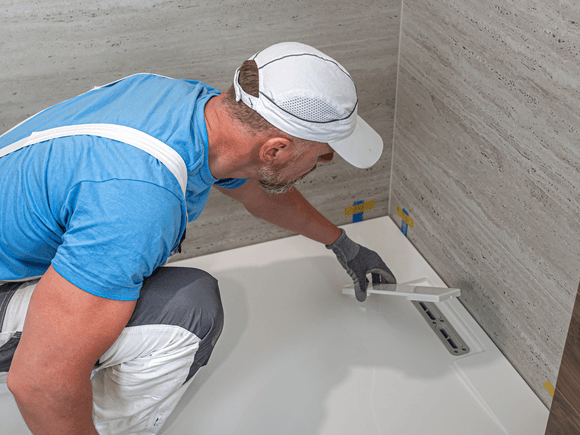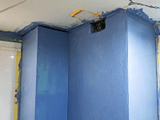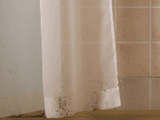How To Repair Polymarble Shower Base Cracks Without Replacing Tiles
Most cracked polymarble shower bases can be repaired for 60-80% less than replacement cost.

You step into your shower one morning and notice it. A thin line running across the base that definitely wasn’t there before. Your stomach drops as you imagine the cost of tearing out tiles, replacing the entire shower, and living through weeks of bathroom renovation chaos.
Here’s what most people don’t realise, that crack in your polymarble shower base probably doesn’t mean you need a complete replacement. Most cracked shower bases can be repaired at a fraction of the cost.
What is polymarble?
Polymarble might look like natural marble, but it’s actually a composite material engineered for bathroom use. The formula combines polyurethane resin with natural marble dust and mineral fillers, creating a solid, non-porous material that handles daily water exposure.
In Australia, you’ll often hear it called Marblelite. The manufacturing process involves casting this resin mixture into moulds, then applying a protective gel-coat layer around 2mm thick. This gives polymarble its characteristic glossy white finish and smooth surface.
The non-porous construction means water and soap residue sit on top rather than seeping in. This makes polymarble naturally resistant to staining and easier to keep hygienic than tiled shower floors with grout lines.
Australian manufacturers have been producing polymarble shower bases for over 35 years. With proper care, a quality polymarble shower base can last 15 to 25 years.
Why polymarble dominates Australian bathrooms
Walk into any bathroom supply store and you’ll find polymarble taking up significant shelf space. Several factors drive this popularity.
Local manufacturing gives polymarble an edge. Companies like Marbletrend produce these bases in Melbourne, designed specifically for Australian building codes and standard bathroom sizes. No import delays, no sizing issues, no compliance headaches.
Cost sits in the sweet spot. Polymarble is far more affordable than custom tiled showers but significantly more durable than budget acrylic options. Installation takes a fraction of the time required for tiling, meaning lower labour costs and less disruption.
Maintenance simplicity matters too. No grout lines to scrub, no tiny crevices for mould, no harsh chemicals needed. A quick wipe with soapy water keeps the surface clean.
The material meets all relevant Australian standards, including AS 3740-2010 for waterproofing, giving builders and plumbers confidence in specifying it.
Polymarble vs acrylic vs stone resin
Understanding where polymarble sits among shower base materials helps inform decisions.
Acrylic represents the budget option. Lightweight and starting around $200, acrylic flexes under weight. This flexibility makes it prone to cracking over time, particularly with imperfect support underneath. Acrylic also scratches more easily.
Stone resin sits at the premium end. Made from crushed stone mixed with resin, these bases feel solid and luxurious. They retain heat well and offer exceptional durability. The downsides are weight and cost, significantly heavier and more expensive than polymarble.
Polymarble falls between these extremes. Heavier and more solid than acrylic means less flexing and better crack resistance when properly supported. The gel-coat surface resists scratches well. Yet polymarble costs substantially less than stone resin while offering good durability.
For most Australian homes, particularly renovations, polymarble hits the right balance of performance and value.
| Material | Price Range | Durability | Weight | Flexibility | Crack Resistance | Best For |
|---|---|---|---|---|---|---|
| Acrylic | $200-$500 | Moderate | Light | High (flexes) | Low-Moderate | Budget renovations, rental properties |
| Polymarble | $300-$1,000 | Good | Medium-Heavy | Low (solid) | Good | Most Australian homes, renovations |
| Stone Resin | $800-$2,000+ | Excellent | Heavy | Very Low | Excellent | Premium bathrooms, high-end homes |
| SMC/Torbex | $400-$800 | Very Good | Light-Medium | Low | Very Good | Modern builds, quality renovations |
Why polymarble shower bases crack
Poor installation support tops the list. Polymarble bases come as self-supporting or non-self-supporting. Non-self-supporting bases require a mortar bed underneath. Skip this or do it poorly, and cracks become inevitable. The base flexes under weight, stress concentrates at weak points, and the material fails.
Air gaps create the same problem. Even small voids mean parts of the base lack support. Thousands of showers later, cracks develop. You can detect this by tapping near a crack. If it sounds hollow, there’s insufficient support underneath.
Building movement contributes as well. Houses settle, foundations shift, high-rise apartments sway slightly. While these movements seem minor, they transfer stress to rigid fixtures. Over time, this causes cracks.
Temperature fluctuations create expansion and contraction cycles. Melbourne’s four seasons in one day weather pattern, combined with hot showers in cold bathrooms, puts thermal stress on the base. Years of these cycles contribute to material fatigue.
Age and wear eventually affect any material. A 20-year-old polymarble shower base has endured decades of hot water, soap, and cleaning products. The gel-coat degrades gradually, and the resin loses structural strength.
Impact damage happens too. Heavy bottles dropped at wrong angles or harsh abrasive cleaners can chip surfaces or wear through the protective gel-coat.
Polymarble crack repair methods and your options
When you discover a crack, assess the damage first.
Hairline cracks that don’t penetrate through the material are easiest to address. Run your finger over it. If you barely feel it, it’s probably superficial.
Through-cracks are more serious. Water penetrates into the subfloor. Test by pouring water on the crack and watching where it goes. If water disappears into the crack, you need proper attention.
Press down around the crack. Does the base flex or feel spongy? That hollow sound when tapping? Both signs point to support problems underneath requiring more than crack filling.
DIY temporary solutions
For tiny hairline cracks not leaking, bathroom silicone sealant can work temporarily. Clean thoroughly, apply silicone along the crack, smooth it, and let cure. This costs $15 to $50 and buys time. But understand this is a stopgap. The underlying problem remains.
Professional repair options
Structural repair with foam support addresses the root cause. A technician drills small holes around the crack and injects expanding polyurethane foam underneath. This fills voids and provides solid support. Once cured, the crack gets filled with two-part epoxy formulated for polymarble. The surface is sanded smooth and polished to match. Done properly, this repair lasts years. Cost sits at $400 to $900.
Shower base relining installs a new acrylic liner over the entire cracked base. The space between fills with polyurethane foam for support. No tiles need removing. Work takes about three hours, and the shower is ready next day. Cost runs $750 to $1,700 for the floor. Many companies offer six-year warranties.
Specialist crack repair without tile removal is the game-changer for property owners. This approach combines support restoration, crack repair, and waterproofing renewal without demolition. The method varies by crack location and severity, but it fixes problems properly without renovation expense and disruption. This represents the most cost-effective approach for lasting repairs.
Resurfacing sprays a new coating over the entire base, covering cracks and refreshing appearance. However, underlying support problems mean further cracking will occur. Resurfacing works best for bases that are worn but structurally sound.
When polymarble shower bases must be replaced
Repair isn’t always the answer. Some situations genuinely require replacement.
Multiple large cracks spreading across the entire base suggest structural failure too extensive to repair economically. Severe flexing across large areas indicates lost structural integrity. Extensive subfloor water damage from months of leaking requires accessing the subfloor anyway.
Mould growth underneath poses health risks requiring base removal for proper remediation. Bases older than 25 years with multiple problems have reached end of useful life. Repeated repair failures suggest the base can’t be salvaged. Non-compliant waterproofing that can’t meet current standards may require replacement.
Get professional opinions before committing. Some contractors push replacement because it’s more profitable. Others might be overly optimistic about repairs. Two or three opinions help inform your decision.
Australian polymarble brands and quality
Marbletrend dominates the Australian market. Their Melbourne facility produces the Flinders range in various sizes. These bases typically include 20-year replacement warranties. Prices range from $333 for smaller sizes to $961 for larger configurations. They use microscopic e-spheres for enhanced compressive strength.
Other quality brands include Bathroom Products Australia, Johnson Suisse’s Daintree range, and Universal, manufacturing for 20-plus years.
Key quality factors include whether the base is self-supporting or needs a mortar bed. Self-supporting bases have thicker construction and simplify installation. Gel-coat layer thickness affects durability and scratch resistance.
Here’s the point that matters most: installation quality affects performance more than brand choice. Even premium bases crack if poorly installed. A mid-range base properly supported and installed outlasts a premium base with installation shortcuts.
Cost comparison for repair vs replacement
Repair costs range from DIY temporary fixes at $10 to $50, up to professional crack repair at $400 to $900. Shower base relining runs $750 to $1,700, while resiliconing costs $500 to $900.
A new polymarble base alone costs $300 to $1,000. Base plus installation can run from $1,500 to $3,000.A complete bathroom renovation with walls and a screen hits $5,000 to $9,000.
Hidden replacement costs matter. Tile removal, disposal, waterproofing to current standards, potential unexpected problems, and bathroom downtime for days or weeks. If it’s your only bathroom, that means alternative arrangements.
Polymarble shower base crack repair without tile removal saves most of these costs. No demolition, dramatically reduced labour, and the bathroom stays functional except briefly during repair.
A professional repair typically costs 60 to 80 percent less than full replacement. A $700 repair versus a $4,000 replacement makes the financial choice clear when the repair will last.
Replacement makes financial sense when the base has multiple major problems requiring several separate repairs, when the subfloor needs work anyway, or when you’re renovating the entire bathroom regardless.
| Service | Cost Range | Timeframe | Bathroom Downtime | Tile Removal Required |
|---|---|---|---|---|
| DIY silicone fix | $10-$50 | 1-2 hours | None | No |
| Professional crack repair | $400-$900 | 3-5 hours | Minimal | No |
| Shower base relining | $750-$1,700 | 3-4 hours | 1 day | No |
| Resiliconing service | $500-$900 | 2-3 hours | Minimal | No |
| Base replacement only | $1,500-$3,000 | 1-2 days | 2-3 days | Yes |
| Complete bathroom renovation | $5,000-$9,000 | 5-10 days | 1-2 weeks | Yes |
Polymarble maintenance and preventing cracks before they start
Clean weekly with warm soapy water and soft cloth. Never use abrasive scrubbers or harsh chemical cleaners. Monthly, remove soap scum with equal parts vinegar and water spray. For stubborn buildup, try baking soda paste left for 15 minutes before gently scrubbing.
Keep drains clear to prevent standing water. Inspect annually for hairline cracks, particularly around drains. Check for flexing by pressing different spots. Inspect silicone seals and reseal when deteriorated.
Ventilation is critical. Run exhaust fans for one to two hours after every shower. This single habit prevents more problems than anything else. Without exhaust fans, open windows and doors for airflow.
For new installations, insist on proper support. Non-self-supporting bases need mortar beds underneath. Verify level installation with correct fall toward drains. Professional installation prevents more cracks than any other factor.
How Melbourne’s climate affects polymarble shower bases
Melbourne’s weather creates challenges for bathroom fixtures. Temperature swings cause materials to expand when warm and contract when cool. This create stress over time.
Humidity varies dramatically. After hot showers, bathroom humidity spikes to 60 to 64 percent. Without proper ventilation, moisture lingers for hours.
Thermal stress from hot showers in freezing weather is pronounced in Melbourne. The contrast between cold air and hot water creates rapid material expansion. Twice daily for years, these micro-stresses accumulate.
Older Melbourne homes often lack modern ventilation. Small windows, no exhaust fans, poorly positioned vents. This extended moisture exposure degrades sealants.
Run exhaust fans for two hours after showers in winter. One hour suffices in summer. Regular maintenance becomes more important in variable conditions. Annual crack checks catch problems early. Proper ventilation isn’t optional in humid Melbourne winters.
Melbourne’s climate won’t break properly installed, well-maintained polymarble. But it will find and exploit any weakness. Stay on top of maintenance, and your shower base handles Melbourne’s weather extremes fine.
Making the right choice for your cracked shower base
A cracked polymarble shower base doesn’t automatically mean expensive replacement. Most cracks can be repaired effectively at a fraction of replacement cost.
Start by assessing damage honestly. Small hairline cracks without flexing often need straightforward repair. Multiple large cracks with significant flexing might genuinely require replacement.
Act relatively quickly once you discover a crack. Small cracks rarely heal themselves. They typically spread, particularly with poor support underneath. A crack repairable for $500 today might require $1,200 in six months.
Factor in total cost, not just repair or replacement price. Replacement means tile removal, disposal, unexpected problems, and bathroom downtime. Repair, particularly methods without tile removal, keeps these costs minimal.
With proper installation, regular maintenance, and prompt attention to problems, polymarble shower bases can last more than 20 years. Even when cracks appear, effective repair options can extend life considerably.
The bathroom industry has evolved. Repair options that didn’t exist 10 years ago are now readily available. Methods avoiding tile removal have changed the economics of polymarble shower base crack repair entirely.
Your cracked shower base isn’t the disaster it might first appear. With the right approach, it’s a manageable problem with cost-effective solutions.
Frequently Asked Questions
Can you repair a cracked polymarble shower base without replacing it
How much does it cost to repair a polymarble shower base crack in Australia
What causes polymarble shower bases to crack
How long does a repaired polymarble shower base last
Should I repair or replace my cracked polymarble shower base
This article provides general information only and should not be considered professional advice. Building regulations and standards are subject to change. Always consult licensed building practitioners and relevant authorities for advice specific to your project. Information is current as of publication date and accuracy cannot be guaranteed.



